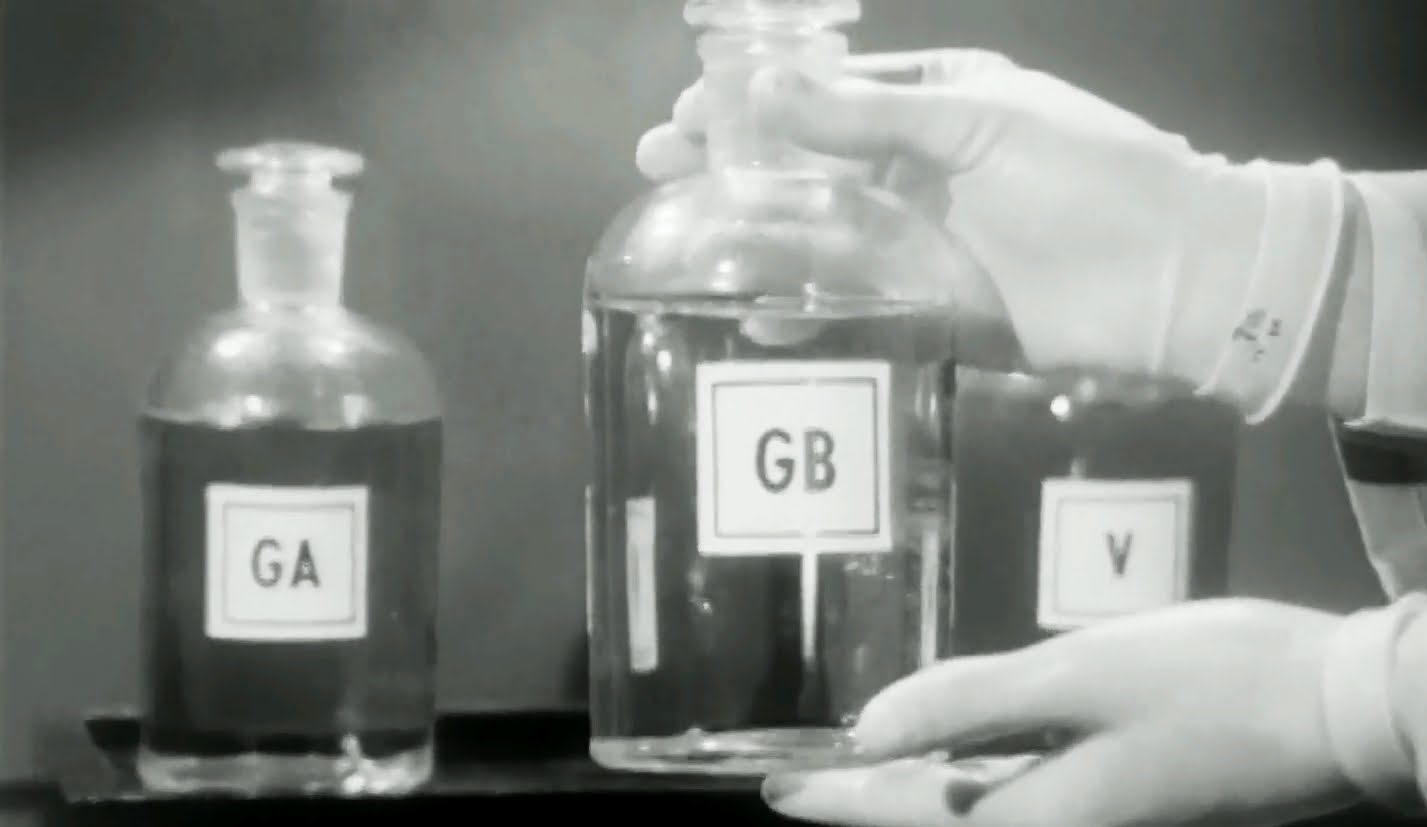more at
“FEATURES AND TACTICAL USE OF GA, GB, AND V NERVE AGENTS – HOW AGENTS ENTER BODY AND SYMPTOMS OF POISONING – PROTECTIVE AND FIRST-AID MEASURES AGAINST THEM .”
US Army Training Film TF3-3432
Reupload of a previously uploaded film, in one piece instead of multiple parts, and with improved video & sound.
Public domain film from the US National Archives, slightly cropped to remove uneven edges, with the aspect ratio corrected, and one-pass brightness-contrast-color correction & mild video noise reduction applied.
The soundtrack was also processed with volume normalization, noise reduction, clipping reduction, and/or equalization (the resulting sound, though not perfect, is far less noisy than the original).
Nerve agents are a class of phosphorus-containing organic chemicals (organophosphates) that disrupt the mechanism by which nerves transfer messages to organs. The disruption is caused by blocking acetylcholinesterase, an enzyme that normally relaxes the activity of acetylcholine, a neurotransmitter.
As chemical weapons, they are classified as weapons of mass destruction by the United Nations according to UN Resolution 687 (passed in April 1991) and their production and stockpiling was outlawed by the Chemical Weapons Convention of 1993; the Chemical Weapons Convention officially took effect on April 29, 1997.
Poisoning by a nerve agent leads to contraction of pupils, profuse salivation, convulsions, involuntary urination and defecation, and eventual death by asphyxiation as control is lost over respiratory muscles. Some nerve agents are readily vaporized or aerosolized and the primary portal of entry into the body is the respiratory system. Nerve agents can also be absorbed through the skin, requiring that those likely to be subjected to such agents wear a full body suit in addition to a respirator…
Biological effects
As their name suggests, nerve agents attack the nervous system of the human body. All such agents function the same way: by inhibiting the enzyme acetylcholinesterase which is responsible for the breakdown of acetylcholine (ACh) in the synapse. ACh gives the signal for muscles to contract, preventing them from relaxing.
Initial symptoms following exposure to nerve agents (like sarin) are a runny nose, tightness in the chest, and constriction of the pupils. Soon after, the victim will then have difficulty breathing and will experience nausea and drooling. As the victim continues to lose control of his or her bodily functions, he or she will involuntarily salivate, lacrimate, urinate, defecate, and experience gastrointestinal pain and vomiting. Blisters and burning of the eyes and/or lungs may also occur. This phase is followed by initially myoclonic jerks followed by status epilepticus. Death then comes via complete respiratory depression, most likely via the excessive peripheral activity at the neuromuscular junction of the diaphragm.
The effects of nerve agents are very long lasting and cumulative (increased by successive exposures) and survivors of nerve agent poisoning almost invariably suffer chronic neurological damage. This neurological damage can also lead to continuing psychiatric effects.
Mechanism of action
When a normally functioning motor nerve is stimulated it releases the neurotransmitter acetylcholine, which transmits the impulse to a muscle or organ. Once the impulse is sent, the enzyme acetylcholinesterase immediately breaks down the acetylcholine in order to allow the muscle or organ to relax.
Nerve agents disrupt the nervous system by inhibiting the function of acetylcholinesterase by forming a covalent bond with the site of the enzyme where acetylcholine normally undergoes hydrolysis (breaks down). The structures of the complexes of soman (one of the most toxic nerve agents) with acetylcholinesterase from Torpedo californica have been solved by X-ray crystallography (PDB codes: 2wfz, 2wg0, 2wg1, and 1som). The mechanism of action of soman could be seen on example of 2wfz. The result is that acetylcholine builds up and continues to act so that any nerve impulses are continually transmitted and muscle contractions do not stop.
This same action also occurs at the gland and organ levels, resulting in uncontrolled drooling, tearing of the eyes (lacrimation) and excess production of mucus from the nose (rhinorrhea).
Antidotes
Atropine and related anticholinergic drugs act as antidotes to nerve agent poisoning because they block acetylcholine receptors, but they are poisonous in their own right…

